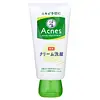Acnes Creamy Face Wash Versus Pigeon Facial Foam
What's inside
What's inside
 Key Ingredients
Key Ingredients

 Benefits
Benefits

 Concerns
Concerns

 Ingredients Side-by-side
Ingredients Side-by-side

O-Cymen-5-Ol
AntimicrobialDipotassium Glycyrrhizate
HumectantCetyl Phosphate
EmulsifyingEcklonia Stolonifera Extract
EmollientOlea Europaea Fruit Oil
MaskingGlycol Stearate
EmollientLauric Acid
CleansingMyristic Acid
CleansingPalmitic Acid
EmollientTocopheryl Acetate
AntioxidantN-Lauryl Diethanolamine
Lauryl Hydroxysultaine
CleansingLauroyl Glutamic Acid
Skin ConditioningGlycerin
HumectantAnhydroxylitol
HumectantButylene Glycol
HumectantLactic Acid
BufferingPotassium Chloride
CI 77288
Cosmetic ColorantCI 77492
Cosmetic ColorantPotassium Hydroxide
BufferingSodium Hydroxide
BufferingParfum
MaskingO-Cymen-5-Ol, Dipotassium Glycyrrhizate, Cetyl Phosphate, Ecklonia Stolonifera Extract, Olea Europaea Fruit Oil, Glycol Stearate, Lauric Acid, Myristic Acid, Palmitic Acid, Tocopheryl Acetate, N-Lauryl Diethanolamine, Lauryl Hydroxysultaine, Lauroyl Glutamic Acid, Glycerin, Anhydroxylitol, Butylene Glycol, Lactic Acid, Potassium Chloride, CI 77288, CI 77492, Potassium Hydroxide, Sodium Hydroxide, Parfum
Water
Skin ConditioningSodium Laureth Sulfate
CleansingCocamidopropyl Betaine
CleansingSodium Stearate
CleansingGlycerin
HumectantPhenoxyethanol
PreservativeMethylparaben
PreservativeButylparaben
MaskingEthylparaben
PreservativePropylparaben
PreservativeCitric Acid
BufferingEthoxydiglycol
HumectantPropylene Glycol
HumectantPEG-26 Jojoba Acid
EmulsifyingPEG-26 Jojoba Alcohol
EmulsifyingButylene Glycol
HumectantPEG-40 Hydrogenated Castor Oil
EmulsifyingSimmondsia Chinensis Seed Oil
EmollientTrideceth-9
EmulsifyingGlycol Distearate
EmollientParfum
MaskingChamomilla Recutita Extract
Skin ConditioningTetrasodium EDTA
Water, Sodium Laureth Sulfate, Cocamidopropyl Betaine, Sodium Stearate, Glycerin, Phenoxyethanol, Methylparaben, Butylparaben, Ethylparaben, Propylparaben, Citric Acid, Ethoxydiglycol, Propylene Glycol, PEG-26 Jojoba Acid, PEG-26 Jojoba Alcohol, Butylene Glycol, PEG-40 Hydrogenated Castor Oil, Simmondsia Chinensis Seed Oil, Trideceth-9, Glycol Distearate, Parfum, Chamomilla Recutita Extract, Tetrasodium EDTA
Ingredients Explained
These ingredients are found in both products.
Ingredients higher up in an ingredient list are typically present in a larger amount.
Butylene Glycol (or BG) is used within cosmetic products for a few different reasons:
Overall, Butylene Glycol is a safe and well-rounded ingredient that works well with other ingredients.
Though this ingredient works well with most skin types, some people with sensitive skin may experience a reaction such as allergic rashes, closed comedones, or itchiness.
Learn more about Butylene GlycolGlycerin is already naturally found in your skin. It helps moisturize and protect your skin.
A study from 2016 found glycerin to be more effective as a humectant than AHAs and hyaluronic acid.
As a humectant, it helps the skin stay hydrated by pulling moisture to your skin. The low molecular weight of glycerin allows it to pull moisture into the deeper layers of your skin.
Hydrated skin improves your skin barrier; Your skin barrier helps protect against irritants and bacteria.
Glycerin has also been found to have antimicrobial and antiviral properties. Due to these properties, glycerin is often used in wound and burn treatments.
In cosmetics, glycerin is usually derived from plants such as soybean or palm. However, it can also be sourced from animals, such as tallow or animal fat.
This ingredient is organic, colorless, odorless, and non-toxic.
Glycerin is the name for this ingredient in American English. British English uses Glycerol/Glycerine.
Learn more about GlycerinParfum is a catch-all term for an ingredient or more that is used to give a scent to products.
Also called "fragrance", this ingredient can be a blend of hundreds of chemicals or plant oils. This means every product with "fragrance" or "parfum" in the ingredients list is a different mixture.
For instance, Habanolide is a proprietary trade name for a specific aroma chemical. When used as a fragrance ingredient in cosmetics, most aroma chemicals fall under the broad labeling category of “FRAGRANCE” or “PARFUM” according to EU and US regulations.
The term 'parfum' or 'fragrance' is not regulated in many countries. In many cases, it is up to the brand to define this term.
For instance, many brands choose to label themselves as "fragrance-free" because they are not using synthetic fragrances. However, their products may still contain ingredients such as essential oils that are considered a fragrance by INCI standards.
One example is Calendula flower extract. Calendula is an essential oil that still imparts a scent or 'fragrance'.
Depending on the blend, the ingredients in the mixture can cause allergies and sensitivities on the skin. Some ingredients that are known EU allergens include linalool and citronellol.
Parfum can also be used to mask or cover an unpleasant scent.
The bottom line is: not all fragrances/parfum/ingredients are created equally. If you are worried about fragrances, we recommend taking a closer look at an ingredient. And of course, we always recommend speaking with a professional.
Learn more about Parfum